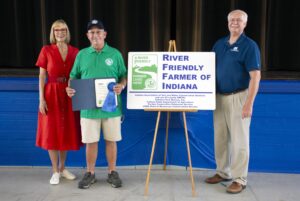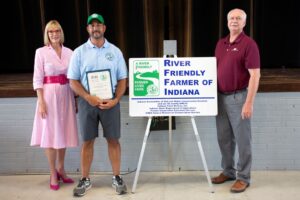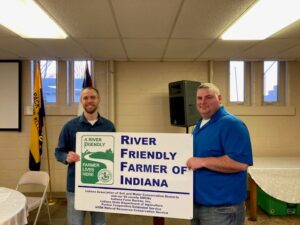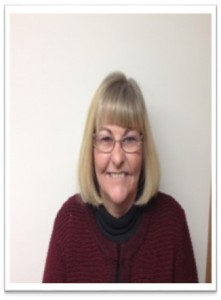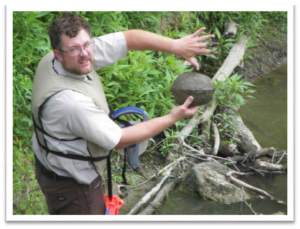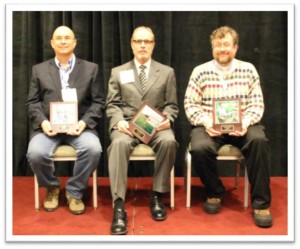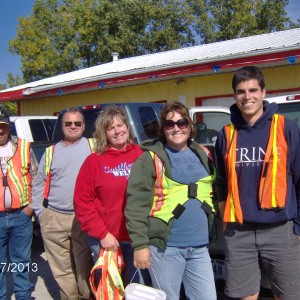2023 Wells County
River Friendly Farmer – Randy McMillan
2022 Wells County
River Friendly Farmer – Andy Evans
2021 Wells County
River Friendly Farmer – Dave Ramseyer
no picture available
2020 Wells County
River Friendly Farmer – Kevin Cassiday
IASWCD District Showcase
2016 Award Winner
| Excess nutrients entering our rivers and streams and water quality issues are a real concern for most communities across our nation. Environmental groups, concerned citizens and local Soil and Water Conservation Districts are working together to promote awareness of these issues and encouraging implementation of conservation practices that will help protect our water resources.Over the past 10 years the Salamonie Reservoir has been affected by a blue-green algae outbreak that has had a great impact on the community, both environmentally and economically. Results from water sampling events conducted by the Army Corp of Engineers, along with Indiana Department of Environmental Management show that the problem is not developing from within the reservoir boundaries, but is due to excess nutrients carried in through the Salamonie River and other tributaries in the watershed.In 2013 the Huntington County Soil and Water Conservation District, along with partnering districts of Wabash, Wells, Blackford and Grant County SWCDs, were awarded an IDEM section 319 Watershed Management Grant for the Lower Salamonie River Watershed (LSRW) area. During the course of our grant, the LSRW group has been conducting water sampling tests, macro-invertebrate samplings and completed a windshield survey to develop a Watershed Management Plan for the LSRW. The information acquired from these sampling events and survey, helped us to identify the most critical areas that need Best Management Practices (BMPs) implemented to help reduce run-off of excess nutrients. The main issues in the critical areas in the watershed showed excess nutrients in the river and streams, soil erosion and lack of conservation tillage. This past year, landowners were able to apply for cost share to implement BMPs such as filter-strips, cover crops, nutrient management, and equipment modifications. Cost share funds of over $76,700 were provided to landowners for implementing BMPs in critical areas and that entailed over 3,100 acres.Excess nutrients entering our rivers and streams and water quality issues are a real concern for most communities across our nation. Environmental groups, concerned citizens and local Soil and Water Conservation Districts are working together to promote awareness of these issues and encouraging implementation of conservation practices that will help protect our water resources. Over the past 10 years the Salamonie Reservoir has been affected by a blue-green algae outbreak that has had a great impact on the community, both environmentally and economically. Results from water sampling events conducted by the Army Corp of Engineers, along with Indiana Department of Environmental Management show that the problem is not developing from within the reservoir boundaries, but is due to excess nutrients carried in through the Salamonie River and other tributaries in the watershed.
In 2013 the Huntington County Soil and Water Conservation District, along with partnering districts of Wabash, Wells, Blackford and Grant County SWCDs, were awarded an IDEM section 319 Watershed Management Grant for the Lower Salamonie River Watershed (LSRW) area. During the course of our grant, the LSRW group has been conducting water sampling tests, macro-invertebrate samplings and completed a windshield survey to develop a Watershed Management Plan for the LSRW. The information acquired from these sampling events and survey, helped us to identify the most critical areas that need Best Management Practices (BMPs) implemented to help reduce run-off of excess nutrients. The main issues in the critical areas in the watershed showed excess nutrients in the river and streams, soil erosion and lack of conservation tillage. This past year, landowners were able to apply for cost share to implement BMPs such as filter-strips, cover crops, nutrient management, and equipment modifications. Cost share funds of over $76,700 were provided to landowners for implementing BMPs in critical areas and that entailed over 3,100 acres. |
Earth Team Volunteer Winner
Mrs. Henderson has volunteered at the Wells County Soil and Water Conservation/Natural Resources Conservation Service since February of 2013. She was formerly the Office Manager at the Wells County Soil & Water Conservation District in the shared offices with NRCS, ISDA and FSA. After 20 years, she chose to take on a new task as Watershed Coordinator for the Upper Wabash River Basin Commission. Along with that she is financial secretary for the Rock Creek Conservancy District. I have worked as the District Conservationist for Wells and Adams County for 4 years. As I split my time with 2 offices, the extra work that Stacia has provided has made a huge impact on my ability to concentrate on more pressing issues.
Stacia has volunteered 148 hours in the time period of October 2013 through September 2014. Stacia has provided support in multiple ways, from helping the newest employee develop a website for the district; as well as assisting with projects along the way. She works diligently to catalog historical information in the way of making scrapbooks; works at cleaning up the old cooperator files which consists of pulling files, going through each piece of paper, determining the need to keep or to move such information to their respective tract files or shredding material that is no longer needed. This in itself has freed up valuable space in our office. Additionally, Stacia has assisted with the completion of a Friend of Conservation application and a CWI grant application for the SWCD. She also attends the SWCD meetings on a regular basis and attends the annual locally led meeting. Stacia has helped with a field day that the SWCD hosted and aided with a demonstration that was held for seniors at the local Parks Dept.
As you can see, Mrs. Henderson is a valuable resource and a dedicated volunteer. She is highly qualified due to her prior knowledge and experience in this office making her perfect as our go to person.
2014 Friend of Conservation Award Winner
Water Quality Monitoring and Education: Rev. Neil Ainslie has used his background in chemistry and Hoosier Riverwatch training to expand his teaching opportunities from private school and home-school programs to a community monitoring and education program. He is currently setting up a not-for-profit organization to continue his mission of connecting citizens with their environment through water quality monitoring.
His programs have included: “Living with the Wabash River,” for adults and youth to learn about the history of the river and what lives in and around it; a “Senior Explorations” class sponsored by the Bluffton Park’s Department to provide information on volunteer opportunities through the Hoosier Riverwatch program and what is involved in monitoring activities; a children’s program sponsored by the Wells Co. Library, and the “Splash on the Wabash” event sponsored in part by the Huntington Co. SWCD to introduce and educate youth and adults on the “water bugs” that indicate a healthy stream or river.
He also coordinates and conducts stream and river water quality monitoring for the Rock Creek Conservancy District and Upper Wabash River Basin Commission throughout the year, where he instructs students and adults on the proper monitoring methods, habitat evaluations and biological monitoring.
Rev. Ainslie’s water quality monitoring program provides insight into the level of contaminants that are causing impairments to our streams and river. The community is using this information to determine which best management practices are needed to minimize the pollution.
This monitoring program will continue under the Upper Wabash River Basin Commission implementation project and be paired with activities of the Wells Co. and Huntington Co. SWCD’s for the promotion of best management practices. As best management practices are adopted it is anticipated that the water quality in our streams and river will improve.
Local Farmer Receive Statewide Award for Conservation Practices
Indianapolis, IN – Out of 61,000 farms in the state of Indiana, one local farms stood out from the crowd last week for the work they do to protect Indiana’s natural resources.
Wells County’s Eric Wenger, EMJ Farms was among fifty-nine farmers who received the River-Friendly Farmer award from the Indiana Association of Soil and Water Conservation Districts (IASWCD) last Wednesday, August 13 at the Indiana State Fair.
The Wells County Soil and Water Conservation District nominated Wenger/EMJ Farms for the award based upon their farm management practices that protect Indiana’s rivers, lakes, and streams.
At the ceremony to congratulate the farmers were Indiana State Department of Agriculture Director Ted McKinney, President of Indiana Farm Bureau Don Villwock, and State Conservationist Jane Hardisty, and IASWCD President Jeff Meinders, among other leaders from the Indiana Conservation Partnership.
The River-Friendly Farmer Award has been presented by the IASWCD and sponsored by the ninety-two local Soil and Water Conservation Districts, and Indiana Farm Bureau, Inc. since 2000. This year’s group of award winners brings the total number of River-Friendly Farmers in Indiana since the award’s beginning to 761.
Wells County Soil & Water Conservation District
Staff & Partners participate in
Adopt A Highway Program
Cleanup crew
Recently, the Wells County Soil and Water Conservation District participated in Adopt-A-Highway, the Indiana Department of Transportation’s program to clean up the roadsides of state and federal highways. Pictured above are, left to right, Dale Thomas, supervisor; Dave Ramseyer, supervisor; Kelley Barkell, District Conservationist; Leann Nash, supervisor; Chad Fiechter, supervisor. Not pictured but also participated was Lynne Huffman, administrative assistant. The area cleaned was Ind. 1 between U.S. 224 and 400N
